Index

Preview: Bunch of non reference designs, good performance and a free game
Nvidia is planning for the GTX 660 Ti to become the new weapon of choice for gamers. The card does offer good gaming performance but the frail, sub-€300 price range, it is the price that often dictates the weapon of choice. Nvidia probably had a god reason for the last minute pric change and the suggested retail pricing for the Geforce GTX 660 Ti 2GB is €259 + VAT.
Good news is that almost all Nvidia partners decided to bundle Borderlands 2, which will be available for download on 21st of September. The game supports PhysX, meaning that Geforce owners will indulge in more realistic effects like cloth simulation persistent particles and dynamic fluid simulations.

Many partners will take part in today’s launch of the GTX 660 Ti. There are already some non-reference coolers and there are factory overclocked models as well. Today, we’ll show you Gainward’s GTX 660 Ti Phantom 2GB and EVGA’s GTX 660 Ti Superclocked 2GB cards in separate reviews of course. Additionally, we’ll show you some other Nvidia partner designs and list some basic specs.
Kepler architecture is not solely performance focused and aims at delivering good performance per Watt ratio, which is pretty much clear when comparing the current to the previous generation. The GTX 660 Ti is said to have a 150W TDP, which is similar to the GTX 560, but the GTX 660 Ti churns out superior performance. The GTX 660 Ti typically draws up to 134W of power in most non-TDP applications. Typical board power for GTX 670 is about 141W while the TDP is at 170W.
The GTX 660 Ti is based on the GK104 GPU, which is used on GTX 690/680/670 cards as wel. The card packs the same number of CUDA cores as GTX 670, 1334 CUDA cores and 7 SMX units. GTX 680 comes with 8 SMX units and 1536 CUDA cores.
The base clock speed is 915MHz, while typical Boost clock is 980MHz. The GTX 660 Ti and GTX 670 run at same clocks and have the same number of CUDA cores but a reference clocked GTX 660 Ti can’t catch up with the GTX 670 due to less ROPs (from 32 on GTX 670 to 24 on GTX 660) and the 192-bit memory interface.
Note that as with previously released Kepler cards, the boost clock speed is based on the average GTX 660 Ti running a wide variety of games and applications and that the actual Boost clock will wary from game to game depending on actual system conditions. We’ve seen that some partners set the base clock beyond 1GHz at launch.
Memory interface is reduced to 192-bit from the 256-bit on GTX 670 cards. There are three 64-bit memory controllers. Interestingly, GTX 660 Ti memory controller supports mixed density memory module operation and we’ll also see GTX 660 Ti cards with 3GB memory.
GTX 660 Ti s memory speed is 1502MHz (6008MHz effective), which means that the memory is clocked the same as on GTX 680/670 cards.




